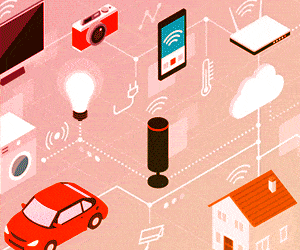Computer scanners and digital cameras, which can see, store and manipulate words and images, are the end product of a technological evolution that began with a single cell, a photocell, also called a photodiode, photovoltaic cell or photo site. The cell is one of the thousands, often millions, etched into the surface of a chip of silicon.
The cell is made by joining two pieces of silicon crystal; only rarely is a single photodiode used by itself. More often, the diode is one of many in a component called a coupled-charge device. Electrical charges built up by the light striking the photodiodes are passed from one diode to the other, like a bucket brigade.
Charges move from the coupled charge device through an amplifier that converts the charges into an electrical current of varying voltages that are an analogue representation of various intensities of light collected by diodes. Current passes through an analogue-to-digital converter; the digital value is in decimal form. A microchip translates the undulating voltages into a series of numbers.
Another microchip uses those numbers to work with a decimal image of whatever the coupled-charge device captured with its thousands of ‘eyes.’
Light-detecting chips built on the coupled-charge device and CMOS model turn up in a variety of computer peripherals, from digital cameras to scanners, copiers and fax machines to biometric identification devices that can visually identify people through their fingerprints, retina scans and facial characteristics.
Q. How does a DLP spin colours and what are the advantages of OLED lights?
A. As an image-projection technology, digital light processing (DLP) is a revelation. It projects brighter, sharper images and has all but replaced film projectors in movie theatres. It works by shining a light through a spinning wheel that has red, blue and green filters. The wheel spins fast enough so that each colour is produced 60 times per second.
The light strikes a panel having up to 1.3 million microscopic mirrors on the surface of the DLP chip. The mirrors reflect the light through a lens to an ordinary projection screen. Electrodes are connected directly to an array of video memory bits so that each electrode can represent a one or zero.
A colour pixel is turned on when a bit is written to the video memory. An electrical charge is sent to the bus and one of the electrodes. Mirrors, functioning as pixels that are turned on, tilt one way to reflect light towards a screen. Mirrors tilted in the opposite direction reflect light to a surface that absorbs it; these represent pixels that are turned off.
Finally, hues of colours are created by how often the source light is turned on and off while the three filters pass in front of it. The colour wheel and RGB data are synched so that the amount of time a mirror takes to reflect any one of the three primary colours is in proportion to the amount of time that that colour in the mixture is perceived by the human eye.
Regarding advantages of OLED lights, unlike LCDs, OLED displays require no backlight. This means that these draw less power. This is a huge benefit, especially when the display is powered by a battery. Some of the illumination in an LED display makes through pixels that are supposed to be totally black, hurting an LED display’s contrast.
OLED displays are also thinner and have a wider viewing angle. OLED displays have been integrated into tablets and smartphones such as Samsung Galaxy, because mobile devices have smaller displays, which means these cost less to produce than OLED displays on desktop monitors.
OLED displays are lightweight, thin and flexible, and we can expect these to appear in places where other types of displays are impractical such as clothing. A t-shirt can change the pattern or colour of the shirt on a whim, and it would not be much more trouble to have it display in a movie or commercial.






